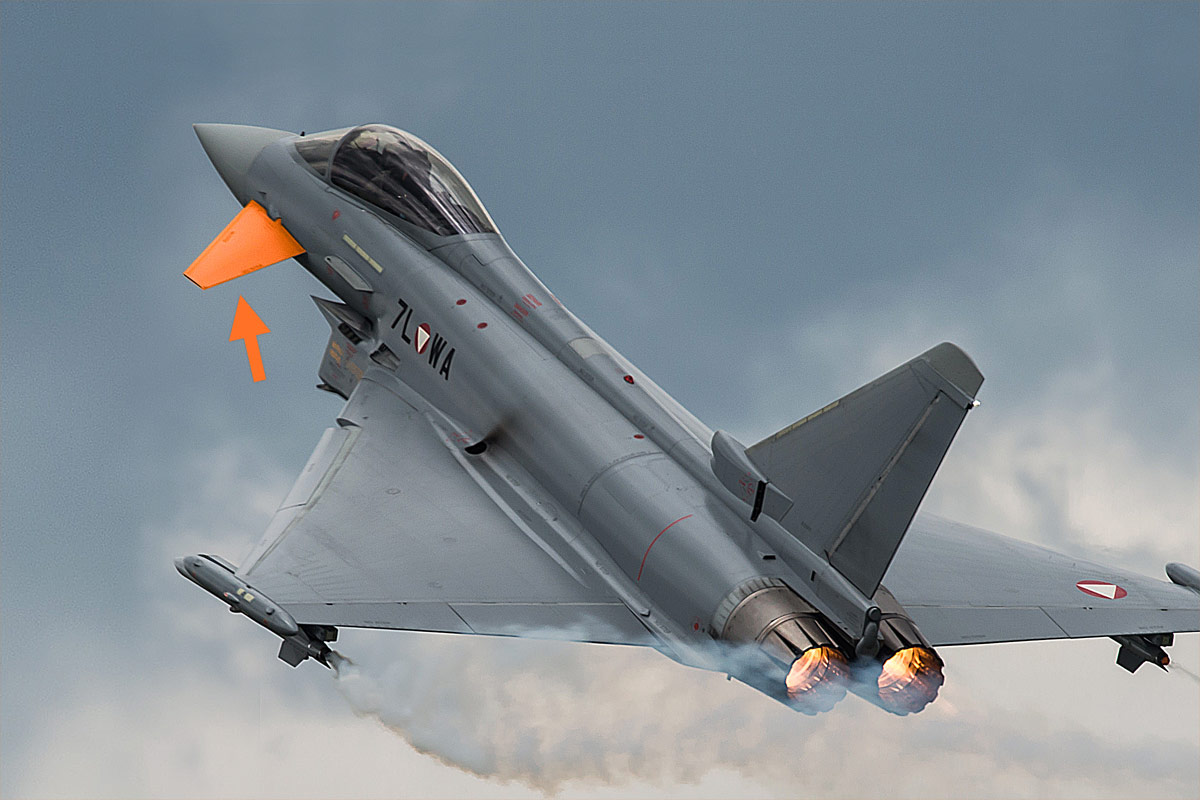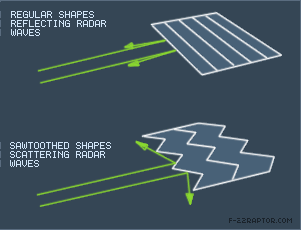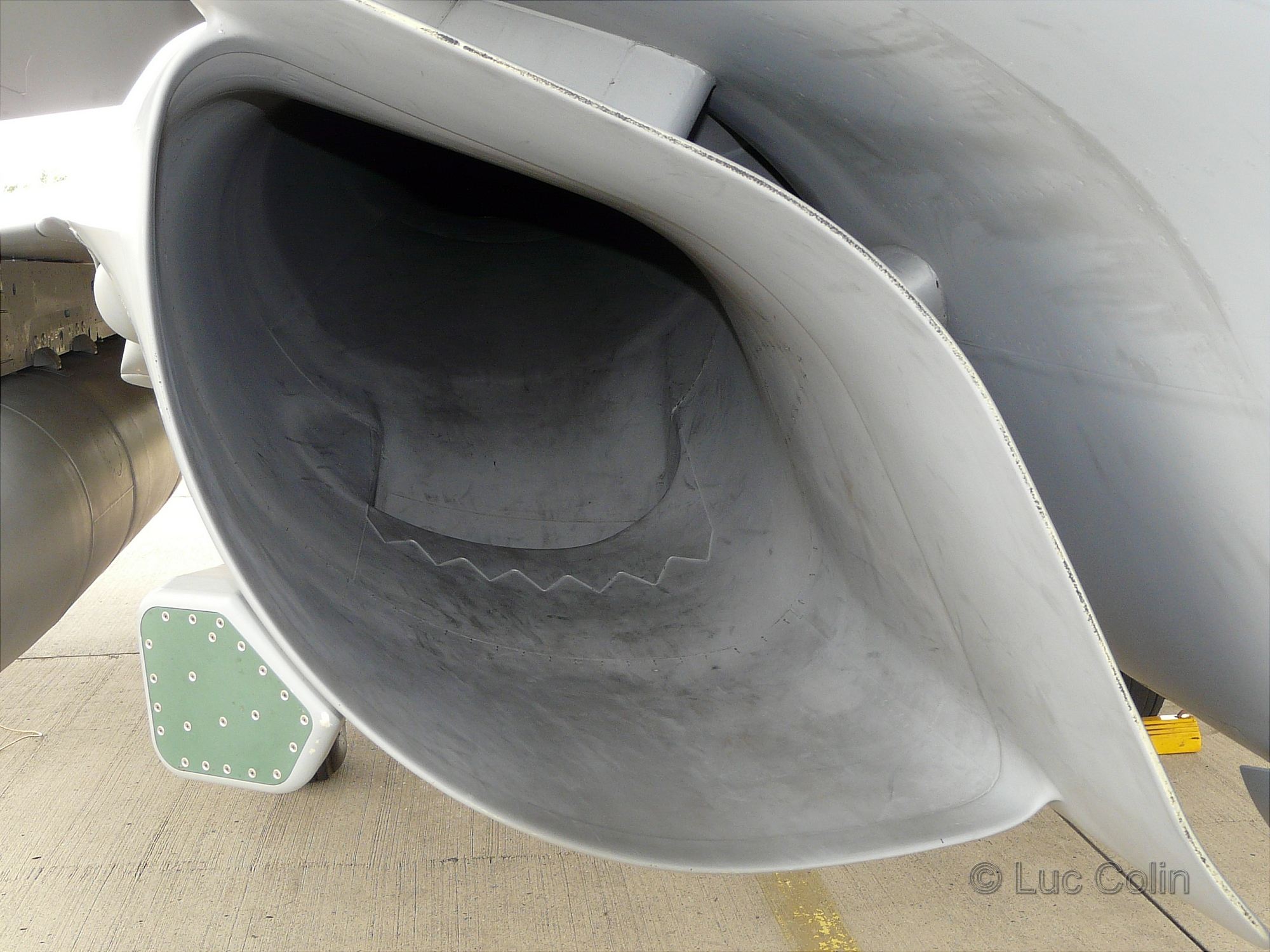اقرأ هذا الكلام عن ايروديناميكية الرافال ... قد تغير رأيك كليا

Aerodynamics
Dassault Rafale is monoplane delta wing aircraft with close-coupled canard. Wings are of mid-wing arrangement with large degree of wing-body blending, resulting in aerodynamically streamlined aircraft with less interference drag than either high- or low- -wing configuration. 48 degree wing sweep results in a transonic bias aircraft with supersonic capability. This lower wing sweep also results in formation of the primary vortex closer to wing surface than in highly-swept (60 degrees or more) delta wings. Additionally, this relatively low sweep compared to some other delta-wing fighters results in lower span loading, minimizing lift-dependent drag. Wing thickness also has impact on maximum speed: thicker wing means lower maximum speed but also better characteristics in combat due to delayed flow separation. Latter shortcoming can be somewhat countered by usage of flaps. Wings can twist to prevent wing tip stalling and subsequent loss of control. Since center of gravity is aft of center of lift, trimming during flight improves maximum lift by maybe 20%.
Wings have launch rail mounted at end, and there is single vertical stabilizer. As unswept wings are limited to subsonic flight, and wings with sweep greater than 60 degrees have poor airfield performance, high lift-induced drag, and poor maneuverability, wing sweep in modern combat aircraft is always between 20 and 60 degrees, something that Rafale’s wing sweep achieves.
Delta wing leading edge creates vortices which help lift at higher angles of attack. Whereas lowly-swept wings as found in civillian aviation stall at AoA values between 14 and 18 degrees, more swept wings offer advantage of strong vortex lift, which can be further improved by high-lift devices such as LERX which strengthen wing vortices. Vortical flows form close to wing’s surface and starts forming at very low angles of attack. End result is large improvement in lift/drag ratio at subsonic speeds for wide AoA range as well as improvement in maximum AoA values. There is, however, large amount of lift-induced drag at subsonic speeds. Another benefit of delta wing is its low wing loading (approximate measure of lift-to-weight ratio) which results in good turn performance; as low wing loading results in high gust sensitivity and is thus undesireable for strike aircraft, Rafale’s very low wing loading makes it obvious that it is optimized for air superiority. High lift coefficient (of which wing loading is part) also improves airfield and cruise performance, but negatively impacts low-altitude penetration.
Additionally, delta wing had good dynamic stall characteristics. As airfoil is rapidly pitched upward, it creates significant vorticity in air flow, improving both lift and pitching moment. Result is an improvement in instantaneous turn rate. Past the Cl(max) AoA, lift loss is more gradual.
Usage of tailless delta means that there is no adverse tailplane/afterbody pressure drag interference, and aircraft does not exhibit Dutch roll when travelling at high speed. However, as there is no tail to provide roll control, and control surfaces are on the wing itself, it means that wing must be stiffer, limiting wing twist and increasing possibility of wing tip stall. Launcher rail located on wing tip improves L/D ratio. Flutter and aerilon reversal are also eliminated, and due to Rafale being unstable, elevons add to lift when turning. Wings themselves are anhedral, reducing lateral stability; this was required due to Rafale’s wide body and wing vertical position. Flaps and aerilons can be used to improve lift during takeoff and landing.
Canards are, as mentioned, of close-coupled configuration. This has benefits on aircraft performance in both subsonic and supersonic flight when compared to conventional delta wing or wing/tail configuration. One of reasons is that canard produces vortices which are very strong immediately behind canard itself, and get progressively weaker, but also a downwash. Properly positioned downwash creates a low pressure region on front part of the wing upper surface which has a significant contribution to lift, and also causes aircraft to be dynamically unstable, providing advantage in response to control surface inputs when compared to either stable or statically unstable configurations. Further, vortices created by canard root, aside from improving wing lift during maneuvers by themselves, interact with vortices created by LERX (LERX itself creates vortices from both root and wing junction, helping both body and wing lift; vortices from canard tip energize outer parts of wings and do not interact with any other set of vortices but help with avoiding wing tip stall and improve response to aeliron inputs); this interaction between LERX and canard root vortices results in vortices being strengthened, prividing large increase in Clmax and decrease in angle of attack for Clmax, by lowering effective angle of attack of the wing. This in turn could have resulted in less lift at very low angles of attack, but vertical separation between canard and wing ensures that it does not become an issue (also a reason for Gripen’s angled canards). It does stabilize detached vortex of the main wing, thus providing greater vortex lift and which results in increase in lift at higher angles of attack; vortex lift also starts sooner for close-coupled canard configuration than for pure delta (and since canard does not interact with the wing, long-arm canard configuration can be considered “pure” delta for purposes of this explanation). Result is that Rafale does not need to achieve as high angle of attack for Clmax as pure delta would have, thus reducing induced drag from which delta-wing aircraft suffer at high angles of attack; it also achieves more lift at Clmax, by up to 50%. Wing center of pressure also moves aft with increasing Mach number due to canard delaying stall over outboard wing panels, and there is reduction in subsonic-supersonic aerodynamic center shift which means that aircraft remains unstable even when supersonic, thus improving maneuvering performance. All of these effects are stronger for canard positioned above the wing than one positioned at same level as wing; movable canard is also better lift-enhancing device than fixed canard or LERX. LERX vortices, aside from helping wing lift, also increase body lift when maneuvering, made possible by large degree of wing-body blending present. Another benefit is reduction in wing bending moment and structural weight due to shift of aerodynamic load distribution inboard.
Close-coupled canards allow Rafale to maneuver in post-stall regime by increasing maximum lift coefficient (Clmax), making it supermaneuverable (post-stall regime is any angle of attack beyond Clmax; TVC is not required for post-stall maneuvers, as even aircraft such as F-18 can achieve angles of attack beyond Clmax. Maximum angle of attack that Rafale has reached during testing is 100 degrees, showing extensive post stall maneuvering capabilities). This is a result of canard-wing vortex interaction, with presence of canard eliminating wing vortex breakdown. PSM can allow Rafale to trade energy for positional advantage in one-on-one aerial combat (this is not as good idea in flight-on-flight or squadron-on-squadron, let alone larger, encounters). They also allow spin recovery and superstall recovery; that is, aircraft with close coupled canards are almost impossible to depart from controlled flight (FCS and machanical problems notwithstanding). Additional advantage of close-coupled canards is that canard root vortexes energize air flow around vertical tail fin, meaning that it remains effective even at high angles of attack (same effect which allows wing control surfaces to remain effective at extreme angles of attack). Reason for this is a constructive interference between vortexes created by canard and those created by LERX, with downwash from canard suppressing flow separation from the wing and canard trailling edge vortex creating low pressure region above main wing surface; this effect is very pronounced in Rafale due to high canard configuration, and region makes a major contribution to lift; in fact, due to vertical separation of canard from wing, vortex lift starts appearing from 4,27 degrees of AoA. Using same effect, Saab Viggen was able to generate 65% greater Clmax at approach than a pure delta wing, achieve much greater trim control than pure tailless delta (such as Mirage) and achieve STOL capability. Rafale has advantage over Viggen in that its canards are controllable, allowing for better control of vortices, and can take off in 700 meters when carrying 4 MICAs and auxilliary fuel tank; minimum takeoff distance is 400 meters and landing distance is 450 meters. When landing, both canards and trailling-edge control surfaces can be used for braking, and Rafale may be able to use canards for braking even while in flight.
Large degree of wing-body blending means that vortices, especially those originating from canard root, allow for large amount of body lift during maneuvers. It also reduces drag in level flight, improving range. Vortexes also make wing more responsive to control surface inputs, including roll.
Along with canards and LERX, Rafale can improve lift at low speeds by using flaps, which help prevent flow separation at higher angles of attack. Combination of LERX, canards and flaps also produces very large drag reductions at typical maneuvering angle of attack, improving sustained turn rate.
In supersonic flight, close-coupled canard-delta configuration suffers from smaller aerodynamic centre shift with Mach number than pure delta, tailed or long-arm canard configuration, leading to lower trim drag due to reduced control surface deflections, and maintaining maneuvering advantages of unstable aircraft (all other configurations result in aircraft becoming stable during supersonic flight; this means slower response to control input and less lift since control surface upward deflections in stable aircraft detract from lift). Combined with already-discussed close-coupled canard features, this results in improved wing response to control surfaces inputs. Close-coupled canard also provides natural damping, making turbulence reduction FCS function unnecessary; while this characteristic is very important in low-level and transonic flight, it helps improve flight characteristic in all flight regimes.
One of important factors in airframe design is that drag rises sharply in transonic region, from mach 0,8 to mach 1,2, often doubling when compared to drag below mach 0,8. At subsonic speeds, lift dependant drag varies inversely with square of the wing span, which means that maximising wing span is desireable. But in supersonic flight, increasing wing span leads to large increase in drag. However, Rafale’s LERX creates shocks at its root, in front of wing leading edge, thus reducing drag and allowing it less sweep and larger wing span than seen in Mirage. This helps counteract drag caused by close-coupled canard.
Mid-wing vertical arrangement is more laterally stable than low-wing arrangement, especially when combined with Rafale’s wide body. As too much lateral stability can cause severe Dutch roll and excessive roll response to lateral gusts, Rafale’s wings are designed with anhedral to reduce stability.
Rafale uses two semi-circular air intakes on the windward side, separated by the body so as to prevent interaction in case of single engine failure. Their position, being shielded by the airframe, provides protection against both high angles of attack (to give an example, F-18s air intakes encounter air flow at around 60% of aircraft’s angle of attack; this is result of both their being shielded by LEX and fuselage to the side of intake redirecting air flow towards the intakes) and yaw angle, as well as sideslip. This design also means that fuselage takes the strain during carrier operations. Intakes are separated from the fuselage so as to avoid capturing the fuselage boundary layer (layer of air where air slows from high velocity relative to aircraft at its edge to standstill at the surface itself) as boundary layer, if enters engine, impairs pressure recovery and increases distortion, thus lowering intake performance; space between intake and fuselage is called external boundary layer bleed. This space is repartitioned, and expansion waves from it energize canard root vortex. Engine cooling duct is also located in this layer. In case that Rafale is equipped with stronger engine, intakes can be enlarged.
There was no need to incorporate moveable lips: engine takes what it needs, and cannot have air forced into it. What this means is that at high air speeds some air spills around the intake as there is more air flow than engine can accept. This may help the above-mentioned effect of canard root vortex energization. As engine can only make use of subsonic air flow, air flow captured in supersonic flight must be slowed down to Mach 0,4-0,5. This is done through series of shocks, with first set of shocks happening at the diffuser plate, second set at air intake mouth and further shocks being generate within the intake; it is addition of diffuser plate that allows Rafale to achieve Mach 2,0.
Dassault has opted to reject dedicated air brake (which was present on Rafale A but not on production Rafales) to save on complexity and weight, as it was deemed unnecessary – Rafale can use its control surfaces (canards and elevons) instead of brake. This also means that there is no 6 o’clock blind point due to using air brake.
Vertical fin is very high in order to remain effective at supersonic speeds, but also due to relative aft location of center of gravity, which requires larger control surface for the same effectiveness. While it may have been rendered ineffective at high AoA in conventional designs, vortices created by LERX and canards mean that it remains an effective control surface even at relatively high angles of attack.
Radome gives good aerodynamic characteristics as well as good radar performance as a result of its axisymmetric shape. Canopy is designed to provide good rearward visibility, though framing limits visibility in some directions; nose shape provides very good visibility over the nose and sides. Framing does allow for a fixed windshield in the event that canopy is detached.
https://defenseissues.wordpress.com/2013/08/24/dassault-rafale-analysis/























